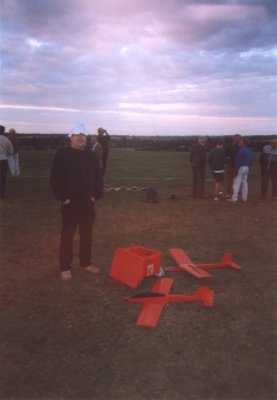
home aircraft books history links old news quotes soft sounds weather
early electric power gliders helicopter indoor technology future
aerojet powered glider filip400 simply the best

My 1st electric aircraft.
Standard 540 size car/buggy motor.
Chosen for its looks and the fact that it is a "wooden" build it yourself
thing.
All 1 piece construction. Wings are flat bottomed section veneered white
foam with balsa leading and trailing edges, and no spars. Not much strength
there then.
The plan shows the aileron servo dropped through the wing centre.
I moved both servos (hitec HS101) just in front of the wing to keep the centre
intact, and put some thin ply across the underside of the join inside the
fuselage. No dihedral.
The power cells are supposed to drop in/out of a hatch at the bottom for
access. I decided to sheet this over, for strength (it lands on this), and
slide the cells in from behind.
Having fitted a ply bulkhead at the front of the wings for the cells to butt
into under landing stresses, I was left with a rather long route for power from
the cells to the motor, around the back of the wing and along the top.
Some heavy gauge single core mains cable reduces the losses, but added extra
weight.
I added a fair bit of extra wood up the front too, as it just didn't seem
strong enough.
Not keen on BEC speed
controllers, I fitted a separate Rx pack (more weight).
I somehow managed to assemble/fit the the tail 0.25" off centre, so the tail
ended up 0.5" shorter than it should be.
Fitting the speed controller immediately behind the motor meant putting the Rx
in the canopy area to keep them separate (interference).
The long nose and forward mounted servos meant fitting the Rx pack well back.
Initially I built the Rx pack inside the tail.

The aerojet with the canopy off.
Left to right - charge connector, 30A blade fuse/holder, chocolate block power
connector, 700mAh Rx pack on wire frame, original futaba Rx (all on extra floor
above aileron push rods), aileron and elevator servos (hitec HS101), switch,
speed controller.
Flew 1st time over at the Wyken nature
reserve.
Fitted with the standard 540 motor and a 7x3 folding prop and 6cells/7.2V it
was rather underpowered.
Even so, it flew quite smoothly and refreshed my flying reflexes.
After 2 successful flights, we decided on a 3rd. On launch it seemed to have
even less power, and my attempts to keep the nose up ended in it landing on its
tail, breaking it off just behind the wing.
Later analysis showed that the car radio fuse holder I had used was just not up
to the job - they are only rated at 5A and the motor takes about 20A.
This had corroded the contacts and produced a high resistance, killing the
power.
I stuck the tail back on, with yet more thin ply across the join. At the same
time, I whipped the Rx pack out of the tail and fitted another at the back of
the canopy area, on a wire frame above the fuse.
The fuse at this time was a soldered in blade (car type), removeable by
chocolate block connector. Later I found suitable blade fuse holders.
In the quest for more power, I gradually fitted larger props, reasoning that an
electric motor under heavier load will slow down and draw more current, hence
more power.
The flaw in this idea is that there is a limit to how much back emf a motor can
generate, determined by the field strength in the permanent magnets.
Eventually the voltage gets stopped by the resistance in the windings leading
to heat. That motor went up in a cloud of evil smelling smoke, before the fuse
blew.
I decided to try the other route to more power - more volts and high revs. I
got a "hotter" buggy motor with fewer turns and a couple of 7cell 8.4V 2000mAh
packs.
With a 7x4 prop this produces an impressive whine and a respectable draught,
although nowhere near enough for a vertical climb.
The performance now is quite spritely on full power, and it shoots about the
sky nicely on 1/2 throttle (see video).
It has to fly fast, because of the high wing loading, and the neutral stability
of the no dihedral low wing means it needs constant attention.
A pretty model, although a jet it is not.
Crunched it a bit sometime 2003 in a heavy landing flying left to right.
Broke the tail off again, and creased the nose.
Found the tamiya power connector a bit melted on 1 side, due to a poor
connection and the heavy current draw.
I stuck the tail back on, but decided that it was not much fun with such a high
wing loading.
Still intact, but in the roof.
| span | area | mass | loading |
| 120 cm | 2128 cm2 | 1409 g | 66.2 g/dm2 |
| 47 in | 2.292 ft2 | 49.7 oz | 21.7 oz/ft2 |

Me with electric aerojet and
powered glider at wolston in about 2002.
Note wheeled flying box containing a car battery for charging.